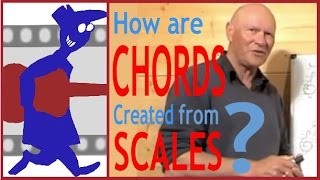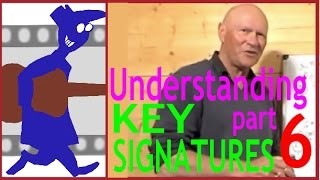Key Signatures Full Circle (Part 1)
Published on 26 January 2016
For more information from the source site of this video please visit: http://secretguitarteacher.com/youtube/advanced/theory/iqabX-8DrTA/84145578-key-signatures-full-circle-1.php
This is a sample lesson from the Secret Guitar Teacher website (see link above).
It is from the advanced section of the site and is most definitely not for beginners!
But if you have already studied the subjects of the circle of fourths and fifths, and how they relate to key signatures, and are feeling that you haven't quite got to the end of the subject - then this video might help!
Here is the abridged transcript:
OK let's look again at the circle of fifths in a slightly different form to the one we have used so far -- a circular form! Here we have a popular way of representing the sharp key signatures starting with the key of C major at the top.
This is our neutral key in the sense that it has neither sharps nor flats. Then we work round clockwise, going up the C scale FIVE notes ('cause this is the circle of FIFTHS) to the key of G which has one sharp, then on to the fifth note in the key of G - D. The key of D major has two sharps -- Then A with three sharps, E with four, B with five etc...
Notice that, in blue writing, we have also included the relative minor keys -- these are keys that share their key signatures with the major key in the same segment of the circle.
Now, what I mainly want to point out to you about this diagram is what we might call the elephant in the room! We have been talking on and on about the CIRCLE of fifths, but quite clearly it's not a circle ...not a complete one anyway...at least... not yet...!
We have come this far by stepping up each scale to the fifth note and then building the next scale on that note and discovering it needs one more sharp... Let's see what happens if we continue that process...I think we'll do this over on the whiteboard
Here's our stave and Key signature for C# Major - Father Charles Goes Down And Enters Battle - Seven sharps.Here's the scale notes Let's name them and number them. Now we take the fifth note G# and use that to build our next key..
Now we'll use the process we used right back at the start of the first lesson we did on this -- we'll check the intervals between these notes against the MAJOR SCALE formula..
What we need is TTSTTTS so where does it go wrong? No great surprise -- it goes wrong at note SEVEN just like it always does in the circle of fifths...But here's the great question...how can we fix it?
The answer is that we take note seven which is F# and add another sharp to it. This makes it F double sharp... And we do the same in the key signature at the start of the line.
Now what does F## sound like? The answer is exactly like the note G. When you sharp a note you raise it a half step or a semitone. So if you do that to F twice you make it sound exactly like G. But why can't we simply call it G?
Because we are in the key of G# major. So every G note gets played as a G#. So we use this trick of double sharping the F and that solves the problem, I think, surprisingly neatly!
So the key of G# major has eight sharps...And there it is in its rightful place on the circle diagram.
From the key of G# major we go up five steps...And we use D# to build our next scale...and we come up with the same problem again at note SEVEN and this time there are no prizes for guessing how we solve it!
Notice that the order of double sharps is hauntingly familiar... F ...C ... Father Charles...This is where you can start to safely predict what happens next...
Now what happens next is strangely satisfying... we are in the key of E# major and we take the fifth note which is B#. It appears to have 12 sharps which is beginning to get a bit silly isn't it?!
Let's take a closer look and see if we can simplify things.. What's another name for the note B#?...So we really have come full circle haven't we. Back to the key of C major where we began the circle.
Call me a sad old so and so, but this is one of my favourite bits of music theory! I think the way it comes full circle and resolves back to the nice simple key of C major is kind of a great relief, because up until that point, it was heading off in an ever more complicated direction wasn't it.?!
Now I more or less promised you earlier that, although this stuff about double sharps is of some practical use in music theory, the chances are very slim that you will ever encounter double sharps in an actual piece of music.
In the final lesson in this series on key signatures, we'll look at why that is as we explore the Inner Circle! Hope that sounds mysterious enough to entice you to join me in that lesson.
See You then!
 RHYTHM GUITAR: Improving Musical Concentration
RHYTHM GUITAR: Improving Musical Concentration
 8 Stretching Exercises For Guitar Players & Other...
8 Stretching Exercises For Guitar Players & Other...
 Composing 3-Part Guitar Harmony
Composing 3-Part Guitar Harmony
 Music Theory: Chord Inversions
Music Theory: Chord Inversions
 Fingerstyle Guitar Exercises That Really Work - In...
Fingerstyle Guitar Exercises That Really Work - In...
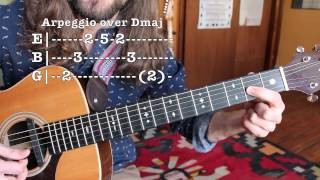 Lead Guitar Lesson - Arpeggios, Scales and Transpo...
Lead Guitar Lesson - Arpeggios, Scales and Transpo...
 Extreme Arpeggio Workout Exercise One Guitar Lesso...
Extreme Arpeggio Workout Exercise One Guitar Lesso...
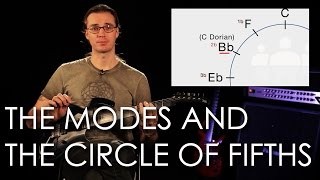 4. The Modes and the Circle of Fifths
4. The Modes and the Circle of Fifths
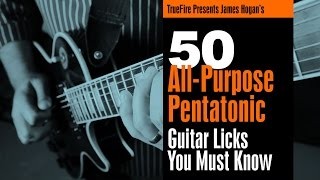 Pentatonic Licks - #47 Mix It Up - Guitar Lesson -...
Pentatonic Licks - #47 Mix It Up - Guitar Lesson -...
 The CAGED System. Part 1 of 2.
The CAGED System. Part 1 of 2.

